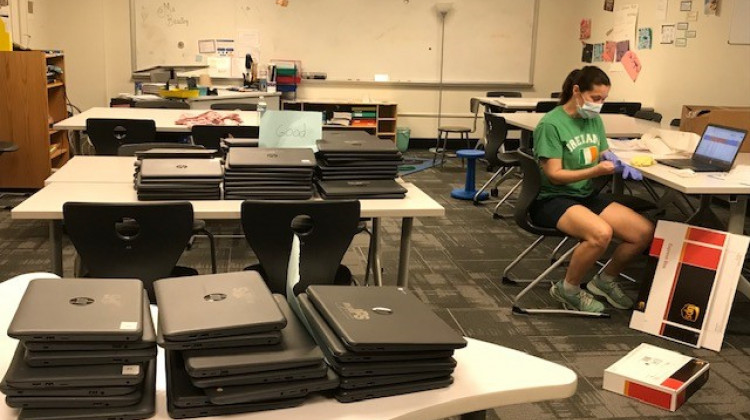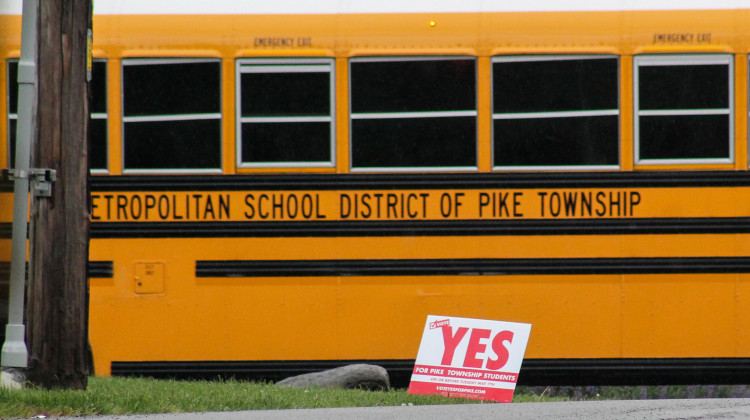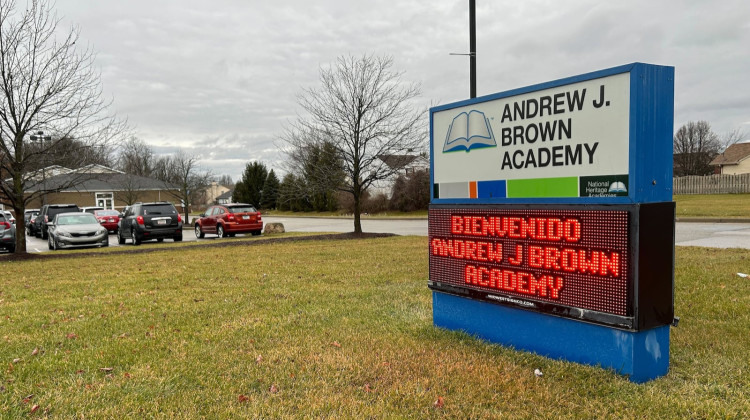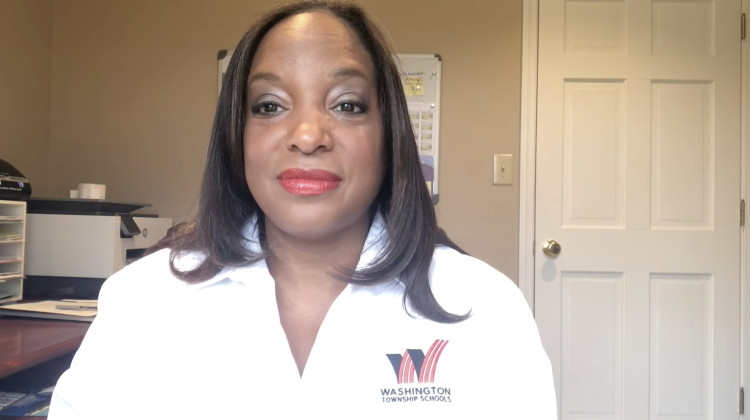
An IPS staff member prepares laptops to be sent to high school students for e-learning.
Indianapolis Public SchoolsThe state’s largest school district, Indianapolis Public Schools, begins its remote learning plan Thursday. It will be the first day of learning since March 12, when the Indianapolis Mayor ordered all public schools to close amidst the surging coronavirus pandemic.
Since then, IPS leaders grappled to develop a home learning plan for a district where large swaths of homes are without broadband Internet access and 66 percent of students qualify for free meals based on their family income. Superintendent Aleesia Johnson says high school students, and especially seniors, became the priority.
“We want to make sure those students don't get off track for graduating, our seniors most urgently. That's an actual time-bound issue we needed to solve for,” Johnson says. “But we also don't want our juniors, sophomores or ninth graders off track of their ability to graduate. And then we just thought about the reality of the fact that families are navigating a lot of stuff right now.”
Johnson says the district seeks to balance the reality of families facing financial challenges, work demands for parents who are essential employees, and the students’ need to finish the school year and perform well.
The solution was for schools to work off a base set of materials designed at the central office that could be adapted on a school-by-school basis.
“So it won't look exactly the same across every school community, which is good, because every school community is different and has different relationships and those kinds of things,” Johnson says.
Here are five take-aways from the IPS plan.
1. What is the home learning plan for the district?
The short-term plan is based on the governor’s original order for schools to remain closed until May 1. IPS is asking families of students in K-8 to work from paper packets mailed to their home. Students in each grade will receive the same packet intended to be a “baseline’ of learning. High school students and some middle school students taking credit-dependent courses will use internet-based e-learning to continue taking the classes they are enrolled in.
The goal, Johnson says, is for students to reach 160 days of instruction this academic year by using a 20-day waiver from the requirement that schools meet for 180 instructional days as allowed by Gov. Eric Holcomb. Some innovation schools that are part of IPS, such as Herron High School and Purdue Polytechnic High School, are administering their own e-learning plans and schedules.
2. What is the IPS home learning schedule?
Home learning begins Thursday, April 9 and Friday, April 10, for all IPS students. Then, starting the following week, distance learning is scheduled for Tuesday, Wednesday and Thursday.
Mondays and Fridays are times for teachers, especially in high schools, to prepare lessons and reach out to families.
Johnson says it’s possible home learning will expand to four days in May.
3. Laptops For All High School Students
Around 6,000 Chromebooks were distributed to students taking courses required for graduation. Those laptops, expected to be returned when school resumes, were collected from classrooms throughout the district.
More devices are needed to ensure all students may get instruction online. Johnson says the district wants to have a device for every student by the fall, as a precaution if remote learning continues. Currently, there is nearly one device available for every three students.
4. How Can Students Without Home Internet Use E-Learning?
A district survey found that 30 percent of families have Internet access at home. That’s based on a current survey response rate of 30 percent. Chiefs For Change, a national nonprofit advocacy group of school leaders that Johnson is part of, donated $125,000 toward portable WiFi hotspots. An additional $10,000 donation from software company Salesforce completed the purchase of nearly 1,500 mobile hotspot devices for families who don’t have internet access.
Internet providers Comcast/Xfinity, Spectrum and AT&T say they are providing free internet to low-income families for e-learning. But some groups, like Chiefs For Change, report families with unpaid cable bills and other financial issues have not been able to get free services.
Johnson says the district is working with corporate partners to purchase additional mobile hotspots for families.
“In my opinion there needs to be a more comprehensive solution for broadband access and internet access in our communities,” Johnson says. “The fact of the matter is, you know, this is another place where disparities and inequity show up.”
5. Safety and Security Precautions For E-Learning
The video conferencing program Zoom has quickly become popular among schools and businesses. The company reduced the cost of its program to help more people use it. But the fast growth came with security and privacy issues, and other concerns. School leaders in New York City, Washington, D.C., and Las Vegas stopped using the video conferencing program for those reasons.
Johnson says IPS is still using Zoom and teachers and other staff are to access it through the district’s secure network.
“That’s another level of security and privacy that we could control for as opposed to (teachers) just creating their kind of personal (account) and then inviting students through that.”
Each Chromebook provided to a student is installed with filters that adhere to the federal Child Internet Protection Act.
Correction: This article misstated the results of an IPS survey for families. Current results of the survey found 30 percent of families have Internet access at home, not how many families had access to a device.
Contact WFYI education reporter Eric Weddle at eweddle@wfyi.org or call (317) 614-0470. Follow on Twitter: @ericweddle.
 DONATE
DONATE








 View More Programs
View More Programs


 Support WFYI. We can't do it without you.
Support WFYI. We can't do it without you.